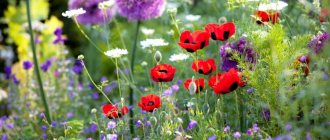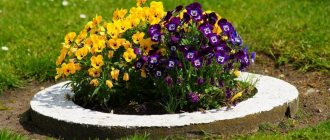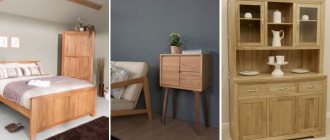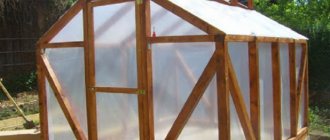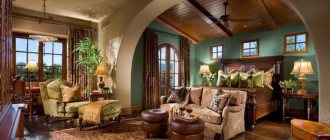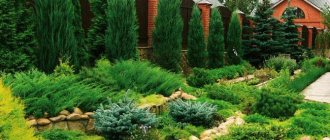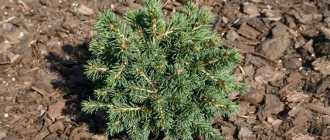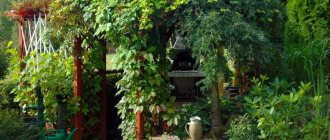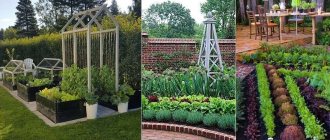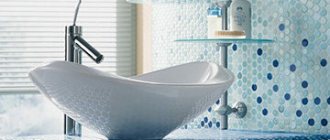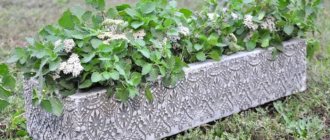Coniferous plants are often indispensable for landscape design. An easy-to-maintain green garden decoration will look great all year round and purify the air. Compositions from coniferous plants are easy to combine with other elements; you can add shrubs, stones and even flowers.
Despite the fact that in nature we have only a few species of conifers, due to introduced species, and even more due to the selection of ornamental varieties, the market offers a choice of hundreds of plants that are resistant to our climate. Therefore, everyone, if desired, can create a corner of harmony on their site to their own taste.
Secrets of creating perfect compositions
Conifers in the landscape design of small areas are often chosen among dwarf varieties. Small plants are compact and do not clutter up the area, but they grow more slowly and therefore may command higher prices. Before buying plants, it is better to draw up a sketch in advance or order a project from us, calculate the required number of plants of each variety, taking into account the available area and the size of adult plants, prepare places for planting, and only then go to the garden center or nursery.
During landscape design, do not forget about the spatial composition; try to make sure that all the elements of coniferous and deciduous plants are combined in size and shape, and do not contradict the surrounding space. It is always easier, cheaper and better to follow existing natural conditions than to try to radically change them. If the neighboring forest grows mainly pine trees, then on your site, most likely, there will also be suitable conditions for them.
Not the last place when drawing up a plan should be occupied by the color scheme - many conifers used in landscape design differ significantly in tone. The palette is varied - there are plants of pale light green, rich green, yellow, blue and other colors. At the same time, the color of the plant changes with the season. Young growths usually look the brightest. If you are thinking over a composition that will include three elements, use no more than two colors. The maximum for a composition of five elements is three colors. In the case of large-scale projects using different breeds over large areas, it is better to separate groups by color to avoid disharmonious combinations.
Harmonious color combination
Much depends on your goals. If the task is simply to decorate the area and try your hand at a new business, then it is better to start with a small project - for example, a flower bed or an alpine slide. Many gardeners choose coniferous trees to create a hedge to separate the area from the neighboring area, extraneous sounds and dust. This way you can zone the space - for example, fence off a utility area or create a garden room. To replace the classic yew hedge, they use common spruce - a very popular option in Scandinavia and Finland, less often other types of spruce - Serbian, prickly. Western thuja hedges are very popular. It grows quickly and lends itself well to molding. Less commonly, hedges are grown from pine trees or junipers.
Coniferous hedge. Serbian spruce, then larch. In the foreground is the mountain pine “Pumilio”.
Creating a landscape design from coniferous plants with your own hands is a difficult but exciting task for beginners. Therefore, if you decide to try, then first study as much material as possible on this topic. Pay attention to one common mistake when conifers are called conifers. Conifers can probably be used in landscape design; but we would not recommend doing this, since growing conifers may fall under an article of the criminal code. Ephedra is a foliage narcotic plant. Don't confuse it with spruce ;)
Advantages and basic tenets of a mixed flower bed
Evergreens are beautiful all year round and require little care. The flower beds in which they grow are called “beds for the lazy” - after all, the main effort has to be spent at the creation stage, when you need to think about the location, composition and layout, purchase seedlings, stones, mulch, and plant correctly. Further care is minimal.
Conifers are also very useful: they secrete phytoncides - volatile substances that can suppress the development of viruses, bacteria, and pathogenic fungi.
Spruce, thuja, and cypress trees planted along the boundaries of the site have a unique resinous aroma and reliably protect from wind, dust, and pollution.
Creating a flower garden with various types of coniferous trees and shrubs requires compliance with certain rules :
- A game of contrasts - neighboring plants should contrast in size, shape, color.
- Priority to compact, low-growing varieties.
- Mandatory consideration of the final size and characteristics of an adult plant.
- The principle of layering - tall forms are given a place in the back row, on the edge or center, in front of them are placed plants of the second tier and low-growing ground cover plants.
- Careful selection of the entire composition - you need to think through the combination and arrangement of different types of conifers, ornamental shrubs, flowering and herbaceous perennials, and annual crops.
- Attention to design - stones are considered, if not mandatory, then a desirable element; a flower bed with conifers looks good on a well-groomed lawn.
- Decorating/mulching the soil surface between plants.
The principles of tiering and contrast do not separate, but unite the participants of a mixed flower bed into a harmonious ensemble
Alpine slide
The Alpine slide is created according to the same principle - creating an imitation of the wild nature of the Alpine belt. Keeping the previous principle in mind, you can combine coniferous compositions in landscape design with other plants and stones. It is important not to fall into typical mistakes described in English literature of the 19th century, and not inadvertently make a “dog’s grave” or “raisin bun”.
Miniature alpine slide - rock garden in a stone trough (miniature rolling pin)
Try choosing a cascading structure to add a special charm to the area. It is important to arrange the parts so that large elements do not block smaller ones.
Common placement options for weeping conifer species
The most common use of coniferous trees is to arrange them among stone boulders when creating a rock garden. For this you will need:
- Select low varieties of conifers and plant them.
- Dig several containers with holes in the bottom near each plant for watering.
- Constantly weed.
- Place blocks of stone and boulders near the planting.
Various varieties of weeping trees, differing in the color of their needles, also look good.
They are usually planted in small groups. Silver, blue and white-variegated conifers look picturesque against the background of plants with dark needles. If the needles of a tree are yellow, you should not place them near green specimens! Otherwise the yellow tree will look sick.
So, coniferous plants with a weeping crown are rapidly entering gardens as specimens for landscape design. There are plenty of tree varieties, so every gardener will be able to design the plot at his own discretion.
Selection of plants for a coniferous composition
When you see a coniferous garden in a photo, it seems that creating your own composition will not be difficult, but the first problems arise almost immediately - when choosing plants.
Choosing conifers is not an easy task
In a small garden, you should not use seedlings of wild spruce and pine trees - it will be difficult to keep them compact, and they will quickly reach their characteristic height and diameter, taking up almost the entire space on the site.
Choose compact plants that have been specifically bred for landscape design, because their growth is not as active and will not negatively affect the composition in the future. This will require special literature and catalogs published by large nurseries or industry associations. The most complete catalog in Russia is published by the Association of Planting Material Producers of Russia, APPM.
Choosing the right plants is the key to success
All conifers can be divided into three groups depending on size:
- Tall growing . This group includes prickly spruce, which can reach 40 meters in height, Serbian spruce with a narrow crown, prickly spruce, including the blue form, Scots pine, Siberian pine (cedar), and pseudohemlock.
- Medium growing . Western thuja and its varieties “Brabant”, “Smaragd” and others, Scots pine “Norske Type”, mountain pine, columnar juniper, some varieties of prickly spruce.
- Undersized . An array of mountain pine “Pumilio”, common spruce “Nidiformis” (nest-shaped form), common juniper “Repanda” (creeping form pressed to the ground), horizontal juniper, microbiota (“Russian cypress” native to the Far East) can look impressive on the site. .
Types of fir trees
The genus Spruce (Picea) includes up to 45 species, which naturally grow in cold and temperate climates, on sandy and rocky soils, and less often in wetlands. The center of origin is considered to be the harsh mountainous terrain of China. The plants are quite unpretentious, drought-resistant, most tolerate the harshest winters without loss, some species are quite tolerant of excessive soil moisture and air pollution.
As soon as you decide on the type and variety of spruce, we recommend reading our article “Spruce - planting and care,” it will help you grow an excellent spruce tree from a spruce seedling.
Norway spruce (Picea abies)
A large tree, growing up to 50 m in height, characterized by a pyramidal crown with a pointed apex. The branches are directed to the sides or obliquely downwards, raised at the ends. The needles are juicy green, glossy, tetrahedral in shape, up to 2.5 cm long. The cones are oblong, greenish or purple when immature. The hardy local species is widespread in the European part up to the Urals, and usually does not cause problems in acquisition and care.
Acrocona
Norway spruce variety Acrocona
A bright, slow-growing variety that appeared at the end of the 19th century in Finland. The crown forms a wide pyramid, is located low, reaches a height of 4 m, with a diameter of 2.5–3 m. The young plant is compact, round in shape. The difference between Akrokona is early, abundant and very colorful fruiting; immature lilac-crimson cones appear in abundance at the ends of skeletal branches and wonderfully decorate the plant.
The needles are dark green in tone, with delicate hanging young growths of a herbaceous hue, which makes a striking contrast. An excellent choice for landscaping small gardens and solitary plantings on the lawn.
Ohlendorffii
Norway spruce variety Ohlendorffii
Dwarf spruce with a compact crown comes from Germany. By the age of ten it reaches 1–2 m, develops slowly, and grows 3–6 cm annually. The crown is wide, first round, then pyramidal in shape, multi-peaked. The branches are dense, spread to the sides and raised at the ends, densely covered with fine green needles, sometimes with a golden tint. The variety is shade-tolerant, unpretentious, suitable for creating mixborders or decorating rocky hills.
Frohburg
Norway spruce variety Frohburg
Swiss original weeping spruce with a straight, slender trunk. The plant is medium-sized; by the age of ten it can grow up to 2–4 m. The branches are sloping, fall to the ground, and spread with age, forming a kind of lush trail, which looks unusual and attractive.
The needles are light green in color, short and stiff. Immature cones are greenish-crimson, growths are emerald green, oblong-round in shape. A stunning variety for solitary plantings, it gives compositions an elegant vertical accent and is of interest to lovers of unusual ornamental plants.
Serbian spruce (Picea omorika)
A tall tree with a narrowed conical or columnar shape with a pointed top. The needles are flattened, glossy, dark green in color, marked on the reverse side with two silvery-white lines. The cones are small, bluish-black in color.
This beautiful, stable species is unpretentious to soils, tolerates air pollution well, and under natural conditions is distributed in the mountainous areas of the Balkan Peninsula.
Nana
Serbian spruce variety Nana
The dwarf variety is characterized by a dense, rounded crown in young specimens, then the crown becomes broadly conical with a pronounced pointed tip. The height of an adult plant is no more than 3.5 m and a width of about 2 m; it develops at a pace that is moderate for low-growing varieties; by the age of ten it reaches one and a half meters.
The main branches are directed obliquely upward, covered with radially directed glossy needles of emerald color with a distinct bluish tint and light stripes on the underside. Planted in oriental gardens, thanks to its spectacular blue tint and compactness, it is successfully used to create contrasting woody compositions.
Peve Tijn
Serbian spruce variety Peve Tijn
The undersized sport of the previous variety was selected by Dutch breeders. The cone-shaped wide crown is very dense, with a smooth, dense surface. It grows by 5–6 cm per year, reaching just over one and a half meters in height by the age of ten. The needles are golden-green with a blue or silver tint. The attractive color combination is especially pronounced on annual growths and in plants planted in open sunny areas.
Canadian or gray spruce (Picea glauca)
A powerful tree reaches a height of 25–30 m; in cultivation it grows moderately – no higher than 10–15 m; in nature it is widespread in the forests of North America. The crown is dense, the main branches of young plants are raised, and those of adults are directed downwards. The needles are thick, bluish-green. The cones are small, light green, turning brown when ripe.
Alberta Globe
Canadian spruce variety Alberta Globe
The miniature, round-shaped plant becomes dome-shaped in maturity. By the age of ten, the diameter of the dense crown is about 30 cm, with annual growth of 2–3 cm; over the years, the lush conifer grows in width up to 0.7 m and reaches 1 m in height.
The needles are light green, elegant, densely covering the dense side branches, forming a bumpy continuous surface. A wonderful variety for planting in rockeries or flower beds, it looks good in homogeneous groups.
Conica
Canadian spruce variety Konica (Conica)
A slow-growing variety of Canadian selection, it is distinguished by a dense conical crown of regular shape. In adulthood, it grows no higher than 2 m with a width at the base of about one and a half meters. The surface is smooth, dense, the branches are directed upward. Spiny elastic needles of juicy green color are located radially.
Konica does not require formative pruning and is wonderful for arranging mixborders, decorating rocky hills and growing in containers. The plant is resistant, prefers sparse partial shade, growths are susceptible to spring burns.
Sanders Blue
Canadian spruce variety Sanders Blue
The famous blue variety is one of the best in its color group. It develops slowly, growing 4–5 cm per year. By the age of ten it reaches 0.7 m in height and 1.3–1.5 m in diameter. The crown is conical, regular, and becomes loose in the shade.
The needles are bright, fresh silver-blue in color, on young growths they are more saturated in color, on old branches they are bluish-green, which is why the surface appears unevenly colored, which is especially noticeable on specimens growing in the shade. Sometimes reversions may appear - completely green branches, which are carefully cut out from the trunk in early spring so as not to spoil the overall impression.
Engelmann spruce or weeping spruce (Picea engelmanii)
Slender conifers up to 50 m high naturally grow on the poor soils of the Rocky Mountains of North America. The crown is cone-shaped, wide, with sloping branches covered with sharp bluish-green needles on the growths, darkening at the base of the branches. The cones are small, oblong-conical, up to 7 cm long, burgundy in color when ripe.
Bush's Lace
Engelmann spruce variety Bush's Lace
A beautiful unusual variety with a straight trunk and a pyramidal loose crown. The young plant actively produces growth - 20–30 cm per year, growing up to 7 m in height and about 1.8 m in diameter. The skeletal branches are raised at the base, drooping at the ends, the lower branches lie on the ground, forming a lush trail.
The main color is bluish-green, the spectacular large growths are bright, contrasting, silver-blue. It looks best solitary in open areas; in the shade it loses its richness of color and attractive shape, growing unevenly.
Snake
Engelmann spruce variety Snake
A tall tree with a sparse crown and bluish-green needles, silvery on growths. The skeletal branches are practically without lateral branching, characterized by growth from the apex, horizontally directed, spread out, slightly raised at the ends. The variety is rare, mainly grown by exotic lovers, excellent as a tapeworm, adding sophistication to oriental and rocky gardens.
Prickly or blue spruce (Picea pungens)
A common cultivated species, beautiful and frost-resistant, tolerates air pollution well. Distributed in the mountainous areas of North America, grows up to 30–40 m in height, characterized by a dense, wide-pyramidal crown, evenly developed. The skeletal branches are directed horizontally, spread out and raised at the ends.
Young shoots are bright brown, bare. The needles are gray, becoming increasingly green with age. The advantage of the species is its tolerance to excess moisture and the ability to develop well in low-lying areas.
Hermann Naue
Prickly spruce variety Hermann Naue
A dwarf, spectacular, cushion-shaped variety, without a pronounced central stem, with numerous lateral branches directed in different directions. By the age of ten, the compact plant reaches half a meter in height and up to 0.7 m in diameter. The needles are bluish-gray, bright. Numerous oblong cones of light brown color appear in abundance at the ends of the shoots at an early age and serve as a wonderful decoration.
The Blues
Prickly spruce variety The Blues
A stunning blue sport of the Glauca Pendula variety. The plant is medium-sized - no higher than 2.5 m and up to 1 m in diameter, with a straight stem and drooping top. The branches are horizontally spread, the ends are directed downwards. The needles are long, silver-blue in color, as if covered with frost, the growths are bright blue. Successfully grafted onto a standard.
Hoopsii
Prickly spruce variety Hoopsii
The classic form of gray spruce was developed in the USA in 1958. The lush beauty does not require a huge plot, growing up to 10–12 m in height and no more than 3–4 m in width at maturity. It develops quickly - 15–20 cm per year, the branches are strong and elastic, and do not break during snowfalls. The crown is harmonious, pyramidal, with outstretched, densely packed skeletal branches and multiple lateral branches, diversified.
The needles are large, up to 2.5 cm long, rich blue in color; the growths are light blue. Small purple cones provide an additional color accent. Looks great in single plantings and alleys, as well as in multi-colored compositions of conifers.
Black spruce (Picea mariana)
A large tree with a narrow pyramidal crown, in natural conditions it grows up to 20–30 m, in cultivation by the age of ten it is no higher than 3 m. The needles are short, bluish-green, and dense. The branches are brick-brown, covered with reddish pubescence. The winter-hardy, unpretentious species does not have a huge selection diversity, numbering only 6–7 varieties.
Nana
Black spruce variety Nana
The dwarf plant is characterized by a dense, rounded-flattened crown with a smooth surface. The main branches are horizontally directed, completely covered with lateral branches directed in different directions. It develops slowly, growing 3–5 cm per year. In adulthood, it reaches no more than half a meter in height and about 1 m in diameter.
The needles are short, bluish-green, on the shoots of the current year they have a spectacular bright green color, contrasting. An unassuming compact variety will serve as a wonderful element of a flower garden and rock garden; it grows well in container culture.
Aurea
Black spruce variety Aurea
A slow-growing tree of a pyramidal shape by the age of ten grows no higher than 1.5–2 m, then growth accelerates, and an adult plant reaches 5–7 m. The branches are outstretched, drooping at the ends, densely covered with short bluish-green needles with cream tips. The growths are much lighter, golden yellow. The elegant conifer looks great both in colorful, diverse compositions and as a solitaire.
Siberian spruce (Picea obovata)
A slender spruce with a narrow cone-shaped crown growing low to the ground is considered one of the most resilient species. Growing shoots are light brown in color, with slight pubescence. The glossy needles are sharp, up to 3 cm long, dark green in color. The species is in many ways similar to Norway spruce, but develops more slowly, reaching a height of no more than 35 m. It is distributed in the forests and mountainous areas of Siberia, China, Mongolia and northern Europe.
Glauka (Var. glauca)
Siberian spruce variety Glauka (Var. glauca)
The medium-sized variation with a pyramidal crown 10–12 m high grows intensively – 20–25 cm per year. The skeletal branches are widely spread, directed obliquely upward, the central stem is smooth and clearly defined. The needles are elastic, linear-needle-shaped, tetrahedral, silver-blue, very impressive. Glauka is highly frost-resistant, unpretentious and quite shade-tolerant. Used as a tapeworm, for group plantings and alleys.
Eastern spruce (Picea orientalis)
A common species grows in the mountainous areas of the Caucasus and northern Turkey. The tree is large, up to 60 m in height. The dense pyramidal crown is symmetrically developed, with branches raised at the base and sloping at the ends. It grows up to 20 cm per year, young trees develop much more slowly.
The needles are short, hard, thick green in color. The cones are a striking reddish-purple hue, oblong, narrowed in shape, 6–8 cm in size. Spruce prefers light soils, does not develop well on heavy soils, and freezes slightly in harsh, dry winters.
Nutans
Oriental spruce variety Nutans
A beautiful tree in the shape of an uneven pyramid, formed by unevenly growing branches, horizontally spread and raised at the ends. The side branches hang down. At first it grows moderately, in adulthood it grows more intensively, growing 20–30 cm per year. Mature trees can reach 18–20 m in height, with a diameter of 7–9 m.
The needles are needle-like, very thick and short, about 1 cm long, dark green, glossy. Young shoots are bright green in color. Immature cones are showy, reddish-purple, mature ones are brown. A fairly large conifer requires sufficient space; it is usually grown in a single planting.
Aureospicata
Eastern spruce variety Aureospicata
The magnificent oriental spruce was obtained by German breeders at the end of the 19th century. A medium-sized tree in maturity reaches 10–15 m, characterized by a wide pyramidal crown, slightly loose. The drooping branches are located unevenly, raised at the ends, the side branches hang beautifully.
The needles are thin, very short, dark green. The greenish-yellow bright growths, as well as small crimson-colored cones, make the conifer especially attractive. The elegant tree is rightfully considered one of the best representatives of the species.
Spruce mariorika (Picea x mariorika)
Obtained by crossing black and Serbian spruce in Germany at the beginning of the 20th century; later, a few but very interesting varieties were bred. It is a large plant up to 30 m high, with a wide pyramidal crown. The branches are horizontally directed, covered with flat bluish-green needles, with distinctive silver stripes on the underside. The cones are small - up to 5 cm long, purple in color when immature.
Machala
Spruce mariorica variety Machala
Czech dwarf variety, up to half a meter high and about 1 m wide, cushion-shaped. The branches are diversified, horizontal, dense, raised from the base. The spiny needles are up to 1.5 cm long, silver-blue in color, lighter on the inside. The origin remains the subject of heated debate - various sources claim that the interesting variety was obtained not from Serbian spruce, but from Iez or, according to another version, Sitka.
Iezskaya or Ayanskaya spruce (Picea jezoensis)
A wonderful coniferous tree, in nature reaching 30–50 m in height, in cultivation by the age of thirty it grows no higher than 8–10 m. Under natural conditions, the species is common in the Far East and the Korean Peninsula, China and Japan, is considered extremely winter-hardy, grows near rivers , loves sprinkling of the crown, shade-tolerant.
The crown is pyramidal, the skeletal branches are directed obliquely upward. Flat needles up to 1.5–2 cm long, blunt or with a small point, dark green, with bluish-white stripes below, last up to 10 years. The needles fit tightly to the branches; in good lighting they tend to puff up, which gives the plant a light silvery tone. The cones are oval-oblong, up to 8 cm long, in an immature state, purple-crimson or light green.
Nana Kalous
Iez or Ayan spruce variety Nana Kalous
A dwarf, squat plant without a pronounced central conductor, round, about 1 m in diameter. The skeletal branches are evenly spaced, directed horizontally and obliquely upward, the lateral branches are short and grow in abundance. The tousled needles with a bluish underside are bright and attractive. Very nice shape, looks good on alpine slides, in the foreground of mixborders.
Subtleties of planting and care
Before planting a tree or shrub, consider that it will need more space in the future, so leave room to spare based on the size of the mature plant. If the diameter of an adult shrub is, for example, three meters, then this is the minimum area that must be allocated for this variety . Several smaller seedlings can be planted in this area, which will quickly close their crowns and cover the ground.
It is important to leave enough space for conifers to grow. The planting density and size of the clumps is determined both by the dimensions of adult plants and the size of seedlings.
Most species require minimal care - systematic watering in the initial period and during drought, weeding, the soil must be loosened and fertilized in a timely manner. You can pinch young shoots to form a crown.
Follow simple but important rules:
- Under no circumstances should the root collar be allowed to go deep. It is necessary to check whether it is buried during the packaging of the plant in the nursery. You need to find the main, skeletal thick roots. The top of the roots extending from the trunk, like the spokes of a wheel, should be located at the level of the top of the soil.
- Mulch the plantings with crushed bark, wood chips or pine needles 4–5 cm thick, without covering the root collar.
- When you combine tall and short plants, achieving harmony can be difficult. To avoid a feeling of clutter, do not choose plants of many types and colors. It is better to use one or two species, or varieties, but in large quantities, than to plant the entire range of the garden center on the site.
- Try playing with geometry by combining different shapes - for example, spherical and pyramidal plants.
The ideal time for planting is spring after the soil has thawed or from late summer to early autumn. In mid-summer you can plant conifers on the site, but it is better to avoid hot periods. It is better to mark planting sites in advance using pebbles or pegs. In this case, it is important to prepare the planting holes and soil - mix the soil with peat and sand. The recipe for the soil mixture depends on the available soil; you can dilute it with sand and peat.
Most conifers prefer well-drained soils, so in areas with heavy, clayey soils you will have to make large planting holes with lighter soil and lay drainage for the bases of the planting holes and pit, leading it into a drainage system or ditch.
Look at the trees growing naturally on and near your property. If these are pine trees, then the soils are most often sandy and light; Spruce trees tolerate dry soil less well.
Newly planted dwarf cedar (Pine pine) and Scots pine (in the background).
When planting a plant with a clod of soil in burlap and netting, after placing the seedling in place in the hole, cut the top of the netting and untie the burlap, find the main roots and make sure that the root collar is not buried. After this, remove the mesh from the top of the ball, fill it with soil around the ball, and spill it with water. Add soil again and compact it with your foot.
When planting a plant from a container, also make sure that the root collar is not buried and that the roots are not curled. If necessary, remove the soil to the level of the root collar, and all small roots that may have grown around the trunk above the main roots. Roots tightly twisted along the walls of the container are a defect; it is better not to take such plants; but cut the top layer with a sharp knife in four to five places, vertically.
After planting, it is better to mulch the tree trunk or the entire clump (chopped bark, wood chips, cones or pine needles are used as mulch, depending on what is available and what is convenient to use). Mulch helps retain moisture, maintain soil life, and discourage weed growth. The thickness of the mulch should be sufficient, at least four centimeters. After planting, water the plants regularly, especially in hot weather. However, you should not overwater them, especially in heavy soil. Roots, first of all, require oxygen, and they should not be allowed to soak for long periods of time. The plant may die.
There is an excellent signal that will help you understand that thujas, ornamental spruces and junipers feel great in a new area - this is the appearance of new growths. Coniferous plants grow actively in central Russia and the North-West in late spring - early summer, then the growth of shoots stops. The second wave of growth, much weaker, occurs in August. Plants need to be planted so that they do not interfere with each other.
Photos and diagrams
The choice of plants, their quantity and combination depends on the size and location of the space that is planned to be allocated for planting ornamental crops on the site.
Mixborders
Mixborder is a complex rectangular flower garden that blooms continuously throughout the season. Its width should not exceed the height of the tallest plant.
Translated from English, mixborder means “mixed border” (mix – “mix” and border – “border”, “border”).
A dwarf pine, two barberry bushes, rock juniper, spirea and hosta planted in a row - although not a full-fledged mixborder, it looks beautiful.
This composition can take place near the fence, against the backdrop of a gazebo, or a bathhouse.
A brighter version of the mixborder - with irises as the central element. The borders of the flowerbed are outlined by cypress and thuja, with spirea bushes and scaly juniper as the border.
Spiraea is notable for its long, abundant flowering and bright foliage color, which goes well with the greenery of the needles
Round and semicircular flower beds
A classic round flower garden can be made in front of the house, in the front garden, or in the garden. The option presented below is collected from shade-tolerant plants.
When planting, it is important to take into account the ability of this form of juniper to grow rapidly horizontally.
A semicircular flower bed with thujas, cypress, spirea and roses is placed in a sunny place or in light partial shade. To maintain the correct shape, a number of spirea bushes are regularly trimmed. You can simplify the task by planting only 3 spirea bushes at an equal distance from each other.
Regular trimming is required to maintain the clear contours of the spirea border.
An interesting option is a round flowerbed made of two parts - the outer hemisphere is formed by 4 spherical thujas, the circle is occupied by juniper, 2 heather bushes and hybrid tea roses
The spherical thuja "Danika" at the age of ten can reach 1 m in diameter and 0.5 m in height. It is unpretentious, tolerates partial shade, but in the sun the needles become brighter and denser.
Corner design
A veranda attached to a house and outbuildings often form corners that remain empty. Such “inconvenient” spaces are best reserved for corner flower beds.
The tile surround and two-color mulching add additional decorativeness to the composition.
Framing garden paths
The path from the gate to the house on one or both sides can be decorated with dwarf junipers and thujas. The alternation of pyramidal and spherical shapes looks good. The spaces between them are usually filled with hostas, heucheras, primroses, chrysanthemum bushes, and bright flowering annuals.
Juniperus 'Blue Star', Heuchera 'Bella Note' and orange daylily form a stylish trio
Pine
Gardeners often choose pine trees for their unpretentiousness to climate and soil.
Pine seedlings
Pine seedlings in the nursery
Pines in the landscape design of the fourth and fifth climatic zones, which corresponds to the most populated territory of the middle zone and north-west, are used as follows: Scots pine, Scots pine “Norske Type”;
Surprising as it may seem, some varieties of very winter-hardy Scots pine growing in the Arctic Circle are not winter-hardy enough in St. Petersburg, including the “Votereri” variety.
- Mountain pine and its many forms and varieties (Pumilio, Mugus, Winter Gold, Pug and others);
- Rumelian pine (Balkan) with very long needles and large cones;
- European and Siberian pine;
- Korean pine, with very large edible nuts;
- dwarf pine (dwarf pine), reminiscent of mountain pine, but with edible pine nuts and bluer needles.
- The once popular Weymouth pines are highly susceptible to attack by rust fungi and are almost out of use.
Pine bonsai against the background of a coniferous hedge
Bonfire
Weeping spruce Bonfire has downward branches. Height – 10 meters. The needles have a bluish-green color. Crown diameter – up to 5 meters. Young shoots are orange-brown in color. The crown is brown, the trunk is curved.
Spruce
This tree, typical of the middle zone, also does not require serious care. In landscape design, common spruce, Serbian spruce, and prickly spruce, which has a green and blue shape, and many decorative varieties are used. For large compositions, tall trees are used.
The blue spruce on the site is not necessarily the blue form of the prickly spruce. In Serbian spruce, due to the color of the underside of the needles, the overall color is also slightly blue.
Spruce on the site. Simple topiary made from Norway spruce
Other spruces are also used:
- Dwarf variety of Serbian spruce “Nana”;
- A spherical variety of prickly spruce with blue needles “Glauca globoza”;
- A narrow-clone variety of common spruce with weeping branches “Inverse”.
Decorating areas near the house with fir trees
The combination of a variety of meadow flowers planted in groups around the spruce will make the landscape unique. Here you can also experiment: for example, plant dwarf spruce trees next to bright flowers. An equally winning option is blue spruce in combination with thujas, cypresses and bright red wild or garden flowers.
Blue spruce, or prickly spruce (Picea pungens) is an evergreen coniferous tree 25-30 m high. Its needles, 15-30 mm long, are painted in a variety of original shades, close in their range to blue. Initially, the tree lived exclusively in several states of the United States; later, its breeding varieties were bred in other countries, including Russia.
Thuja occidentalis
These trees, originally from the west coast of the United States, have long been naturalized in Europe, easily adapt to different conditions, and are not afraid of frost and city air. Easy care and a wide variety of crown shapes make them desirable guests in summer cottages.
Thuja occidentalis on the site
Plants easily fit into different compositions. Thuja makes dense hedges.
Yew hedge. Sissinghurst, UK
Hedges are great for defining green rooms in an area. This hedge of thuja occidentalis 'Brabant' separates the economic area with a vegetable garden from the residential part of the site
Combination of tall and dwarf spruces
Inverse spruce with weeping needles is perfect for the original decor of a summer cottage. Due to its originality, it can be combined with almost any plant, and for contrast, you can plant some kind of dwarf spruce nearby. The advantage of Inverse spruce is that it can be given any desired height.
Spruce Inversa (Picea abies Inversa) is a variety of common spruce, which is called weeping because of the similarity of its shape to willow: its shoots hang strongly, and the lower branches of an adult tree lie on the ground. Inversa can grow up to 6-8 m, the diameter of an adult tree is from 2 to 2.5 m. It has thick shiny dark green needles.
Juniper
A wide selection of junipers - although there are only a few species suitable for climate zones 4 and 5, they have developed varieties of different sizes and shapes, ranging from trees up to ten meters high, to creeping shrubs with a diameter of several meters, but a height of centimeters.
Juniper. Botanical Garden in Brno
Juniper has gray cones that are used to make gin.
Planting spruce trees with contrasting needles
Due to the color of its crown, Hoopsey spruce will be an excellent contrast when paired with Norway spruce. This composition can be used to decorate any place in the garden, but spruce trees planted along the path to the house will look most advantageous.
Hoopsii Spruce (Picea pungens Hoopsii) is considered the most brightly colored of all known blue spruces: young needles are light blue in color, and the tree itself has a silvery tint. In 10 years it grows to approximately 5 m, in 30 years – up to 10 m. The diameter of an adult plant is 4 m.
Yew
The yew is the only native conifer in the UK and is associated with perfectly trimmed hedges and free-standing dark conifers. Unfortunately, winter-hardy yew species are very difficult to find, and most yews from Europe do not winter well in our country .
Yew berry, hedge at Sissinghurst
Ate along the path
Decorative blue spruce along the garden path
Decorative spruce Konika in combination with other conifers and flowers of various colors is an example of the original design of a garden path.
Canadian spruce Konica (Picea glauca Conica) - one of the varieties of Glauka spruce (Picea glauca) - was named so due to the fact that it looks like a cone. It is a dwarf form of Canadian spruce, however, it does not grow higher than 1 m. Its thin and short needles are colored bluish-green.
Advantages of conifers
Planting evergreens on a site provides great advantages over other plants.
- Aesthetics. Conifers retain their decorative appearance throughout the year, regardless of weather conditions.
- Diversity. Numerous varieties will help you create living compositions of different shapes and colors.
- Unpretentiousness. Such green spaces do not require constant maintenance. They grow in all types of soil and do not require a lot of sunlight or regular watering, so any area of the yard is suitable for planting.
- Environmentally friendly. Conifers secrete essential oils, enriching the surrounding air with the rich scent of the forest.
Dwarf conifers in landscape design
In modern gardening, dwarf coniferous trees are experiencing the peak of their popularity. They are a decoration for any garden plot. There are connoisseurs who collect entire collections of dwarf fir, spruce, pine and other representatives of the species.
The most successful people in growing small coniferous trees are in Holland. They offer a conditional classification of conifers:
- full-grown - growth is up to 30 cm per year, at the age of 10 years such coniferous crops reach a height of 3 m;
- medium-sized (semi-dwarf) - their size ranges from 15 to 30 cm;
- dwarf - no higher than 15 cm;
- mini-dwarf - up to 10 cm;
- microdwarf - no more than 5 cm.
Small conifers are used almost everywhere: single or group plantings, flower beds, containers. They are often located at the entrance to the house. Dwarf coniferous plants for the garden will attract attention in any type of landscape.
Advice! When purchasing small forms of trees, you need to carefully study the name - the form nana, dwarf or prostrata should be written on the label.
Experienced gardeners can determine at first glance how much a dwarf tree can grow, which allows them to correctly place it on the site.
